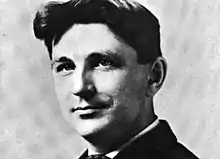John Buckley (attorney)
John Buckley (May 12, 1885 – December 11, 1959) was an American attorney who served as the United States Attorney for the District of Connecticut under two presidents.[1] He also served in the Connecticut House of Representatives[2] and United States Army.
John Buckley | |
|---|---|
 | |
| Member of the Connecticut House of Representatives from Union | |
| In office 1909–1910 | |
| In office 1921–1922 | |
| United States Attorney for the District of Connecticut | |
| In office 1925–1933 | |
| President | Calvin Coolidge Herbert Hoover |
| Preceded by | Allan K. Smith |
| Succeeded by | Frank Bergin |
| Personal details | |
| Born | May 12, 1885 Stafford, Connecticut |
| Died | December 11, 1959 (aged 74) Union, Connecticut |
| Political party | Republican |
| Spouse(s) | Grace R Gaylord Buckley |
| Alma mater | University of Maine Law School (1907) University of Maine (1908)(L.L.B.) |
| Profession | Lawyer, politician |
| Military service | |
| Allegiance | |
| Branch/service | |
| Years of service | 1917–1920 |
| Rank | Major |
Biography
John Buckley was born in Stafford, Connecticut in 1885. He lived there until he was seven years old, when he moved to Union where he would live for the rest of his life. He was educated in the Union public school system and eventually went on to the University of Maine for graduate and law school. In 1909 he was the youngest sitting member of the Connecticut House of Representatives. He served two terms in that forum, both representing Union. In the mid 1910s he served as the private secretary to Governor Marcus H. Holcomb.[3] In 1925 he was named the United States District Attorney for the District of Connecticut, a position he held for several years.[4]
References
- "About the Office". www.justice.gov. March 18, 2015. Retrieved November 11, 2020.
- Taylor, William Harrison (1912). Legislative History and Souvenir of Connecticut: Volume 8.
- "The Political Graveyard: Index to Politicians: Buckley". politicalgraveyard.com. Retrieved January 15, 2021.
- Taylor, William Harrison (1912). Legislative History and Souvenir of Connecticut: Volume 8. p. 292.
 This article incorporates text from this source, which is in the public domain.
This article incorporates text from this source, which is in the public domain.